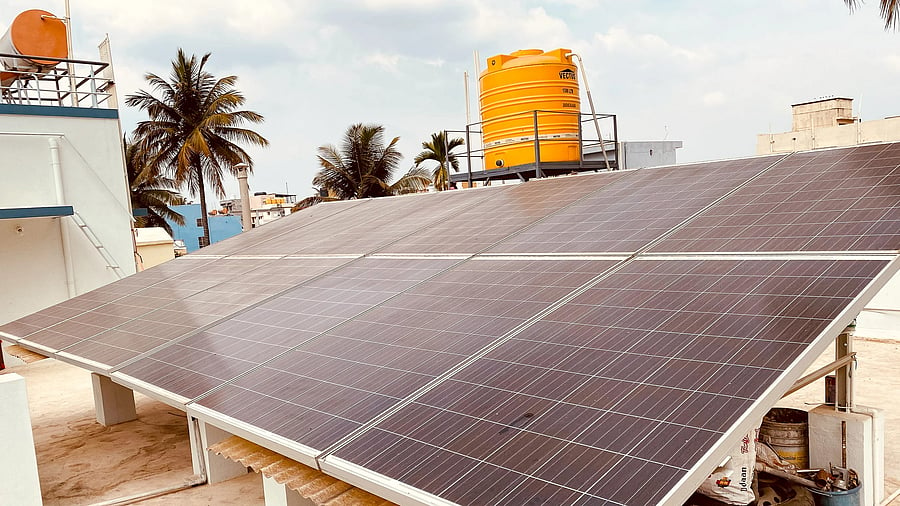
The Union government provides a maximum subsidy of Rs 78,000 for installation of 3-KW solar panels.
Credit: DH file photo
Union government’s ambitious PM Surya Ghar: Muft Bijli Yojana (PMSG:MBY), which aimed at installing rooftop solar panels on domestic houses, is getting lukewarm response in the state as the conversion from application to installation is not even five per cent.
According to documents available with DH, nearly 2.23 lakh people applied under the scheme since its launch in February 2024. However, only 10,672 applicants benefited as of July 2025.
More than 15.76 lakh households have benefited from this scheme across India so far.
Experts point out the tedious process, non-availability of domestically manufactured solar panel modules, lesser subsidy and
incentive on purchase of power, and Karnataka’s Gruha Jyothi scheme as reasons for the lack of interest.
On average, India requires 30 GW of solar panels per year. Last year, the country produced 25 GW of solar panels as manufacturers were allowed to use imported components. However, with the Union government making it mandatory that only domestically manufactured modules should be used, this year the country is expected to make 8 GW to 10 GW of panels, says Karnataka Renewable Energy System Manufacturers’ Association Founding President Ramesh Shivanna.
The Union government provides a maximum subsidy of Rs 78,000 for installation of 3-KW solar panels. Ramesh says availability of Domestic Content Requirement (DCR) modules is difficult and costlier compared to those exported.
“A 3-KW solar panel and its allied equipment can be installed at an estimated cost of Rs 2.25 lakh. However, the subsidy provided is not even one-third of it. Descoms purchase excess power at Rs 2.46 from beneficiaries. This is too low,” he says.
The beneficiaries also complained of the vendor selection process while applying online. “There is a complicated process of selecting the vendors. Though the website shows multiple options, at the time of selection it gives us only a few vendors who quote higher prices,” says Ganapathi Bhat, a resident of Hubballi who left the process midway.
The fear of losing Gruhajyothi scheme benefits also detests many from applying for PMSG:MBY.
“At present, only those households which consume more than 200 units of electricity can benefit if they install a 3-KW unit. Many customers have withdrawn their application due to this,” says Santosh Kumar, an authorised vendor.
Hubballi-Escom Managing Director Vyshali M L says many applicants apply randomly and back-off at the time of vendor selection after realising that only 50% of the total cost of installation is subsidised.
She says there is no dearth of solar panels. “More than 52,000 households under Hescom are out of Gruhajyothi scheme and we are targeting them for PMSG:MBY. Going is a bit tough,” she says.
‘K’taka not showing interest’
Speaking to DH, Union Minister of New and Renewable Energy Pralhad Joshi said unlike other states, Karnataka is not showing much interest in the scheme.
“It’s a demand-driven scheme. The Union government has set aside Rs 75,021 crore for this scheme. Several states in the country are taking benefit of the scheme, which not just increases their power generation but also reduces burden on government spending. Unfortunately, Karnataka is not utilising it.”
He says Karnataka government is more interested in purchasing fossil-fuel at Rs 6 a unit, but not ready to incentivise green energy
production.